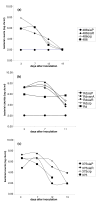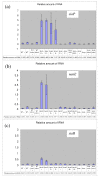Sialic acid mediated transcriptional modulation of a highly conserved sialometabolism gene cluster in Haemophilus influenzae and its effect on virulence
- PMID: 20158882
- PMCID: PMC2836998
- DOI: 10.1186/1471-2180-10-48
Sialic acid mediated transcriptional modulation of a highly conserved sialometabolism gene cluster in Haemophilus influenzae and its effect on virulence
Abstract
Background: Sialic acid has been shown to be a major virulence determinant in the pathogenesis of otitis media caused by the bacterium Haemophilus influenzae. This study aimed to characterise the expression of genes required for the metabolism of sialic acid and to investigate the role of these genes in virulence.
Results: Using qRT-PCR, we observed decreased transcriptional activity of genes within a cluster that are required for uptake and catabolism of 5-acetyl neuraminic acid (Neu5Ac), when bacteria were cultured in the presence of the sugar. We show that these uptake and catabolic genes, including a sialic acid regulatory gene (siaR), are highly conserved in the H. influenzae natural population. Mutant strains were constructed for seven of the nine genes and their influence upon LPS sialylation and resistance of the bacteria to the killing effect of normal human serum were assessed. Mutations in the Neu5Ac uptake (TRAP transporter) genes decreased virulence in the chinchilla model of otitis media, but the attenuation was strain dependent. In contrast, mutations in catabolism genes and genes regulating sialic acid metabolism (siaR and crp) did not attenuate virulence.
Conclusion: The commensal and pathogenic behaviour of H. influenzae involves LPS sialylation that can be influenced by a complex regulatory interplay of sialometabolism genes.
Figures






Similar articles
-
Host-derived sialic acid is incorporated into Haemophilus influenzae lipopolysaccharide and is a major virulence factor in experimental otitis media.Proc Natl Acad Sci U S A. 2003 Jul 22;100(15):8898-903. doi: 10.1073/pnas.1432026100. Epub 2003 Jul 10. Proc Natl Acad Sci U S A. 2003. PMID: 12855765 Free PMC article.
-
Regulation of sialic acid transport and catabolism in Haemophilus influenzae.Mol Microbiol. 2007 Oct;66(1):26-39. doi: 10.1111/j.1365-2958.2007.05890.x. Mol Microbiol. 2007. PMID: 17880422
-
Sialic acid transport in Haemophilus influenzae is essential for lipopolysaccharide sialylation and serum resistance and is dependent on a novel tripartite ATP-independent periplasmic transporter.Mol Microbiol. 2005 Nov;58(4):1173-85. doi: 10.1111/j.1365-2958.2005.04901.x. Mol Microbiol. 2005. PMID: 16262798
-
Profiling structural elements of short-chain lipopolysaccharide of non-typeable Haemophilus influenzae.Innate Immun. 2008 Aug;14(4):199-211. doi: 10.1177/1753425908095958. Innate Immun. 2008. PMID: 18669606 Review.
-
Expression and structural diversity of the lipopolysaccharide of Haemophilus influenzae: implication in virulence.Int J Med Microbiol. 2007 Sep;297(5):297-306. doi: 10.1016/j.ijmm.2007.03.007. Epub 2007 Apr 23. Int J Med Microbiol. 2007. PMID: 17452015 Review.
Cited by
-
Structural and biophysical analysis of a Haemophilus influenzae tripartite ATP-independent periplasmic (TRAP) transporter.Elife. 2024 Feb 13;12:RP92307. doi: 10.7554/eLife.92307. Elife. 2024. PMID: 38349818 Free PMC article.
-
Bacterial Sialic Acid Catabolism at the Host-Microbe Interface.J Microbiol. 2023 Apr;61(4):369-377. doi: 10.1007/s12275-023-00035-7. Epub 2023 Mar 27. J Microbiol. 2023. PMID: 36972004 Review.
-
Degradation, foraging, and depletion of mucus sialoglycans by the vagina-adapted Actinobacterium Gardnerella vaginalis.J Biol Chem. 2013 Apr 26;288(17):12067-79. doi: 10.1074/jbc.M113.453654. Epub 2013 Mar 11. J Biol Chem. 2013. PMID: 23479734 Free PMC article.
-
Selective Nutrient Transport in Bacteria: Multicomponent Transporter Systems Reign Supreme.Front Mol Biosci. 2021 Jun 29;8:699222. doi: 10.3389/fmolb.2021.699222. eCollection 2021. Front Mol Biosci. 2021. PMID: 34268334 Free PMC article. Review.
-
Gene content and diversity of the loci encoding biosynthesis of capsular polysaccharides of the 15 serovar reference strains of Haemophilus parasuis.J Bacteriol. 2013 Sep;195(18):4264-73. doi: 10.1128/JB.00471-13. Epub 2013 Jul 19. J Bacteriol. 2013. PMID: 23873912 Free PMC article.
References
-
- Hood DW, Makepeace K, Deadman ME, Rest RF, Thibault P, Martin A, Richards JC, Moxon ER. Sialic acid in the lipopolysaccharide of Haemophilus influenzae: strain distribution, influence on serum resistance and structural characterization. Mol Microbiol. 1999;33(4):679–692. doi: 10.1046/j.1365-2958.1999.01509.x. - DOI - PubMed
-
- Bouchet V, Hood DW, Li J, Brisson JR, Randle GA, Martin A, Li Z, Goldstein R, Schweda EK, Pelton SI. Host-derived sialic acid is incorporated into Haemophilus influenzae lipopolysaccharide and is a major virulence factor in experimental otitis media. Proc Natl Acad Sci USA. 2003;100(15):8898–8903. doi: 10.1073/pnas.1432026100. - DOI - PMC - PubMed
-
- Jurcisek J, Greiner L, Watanabe H, Zaleski A, Apicella MA, Bakaletz LO. Role of sialic acid and complex carbohydrate biosynthesis in biofilm formation by nontypeable Haemophilus influenzae in the chinchilla middle ear. Infect Immun. 2005;73(6):3210–3218. doi: 10.1128/IAI.73.6.3210-3218.2005. - DOI - PMC - PubMed
Publication types
MeSH terms
Substances
Grants and funding
LinkOut - more resources
Full Text Sources
Research Materials
Miscellaneous

